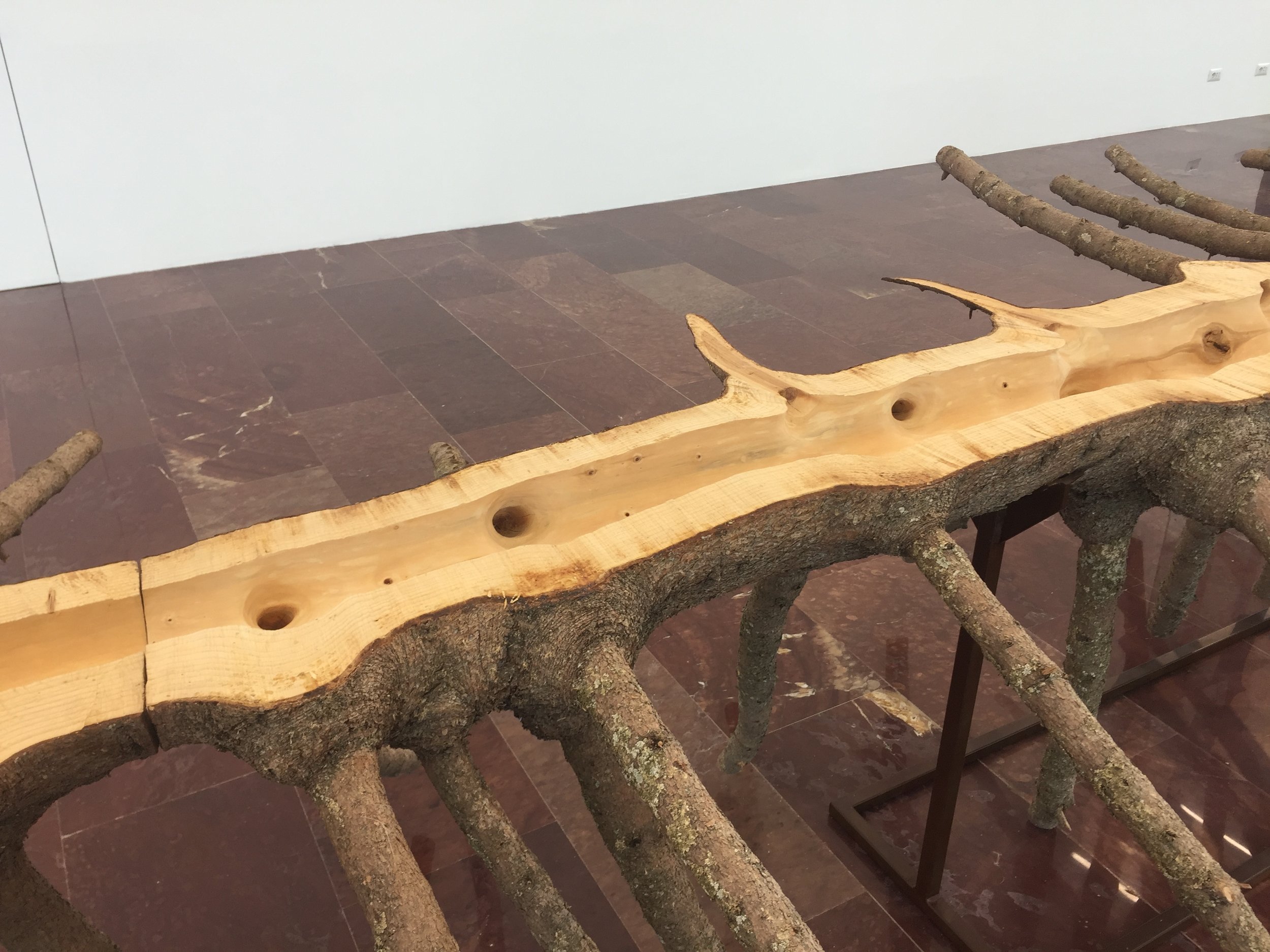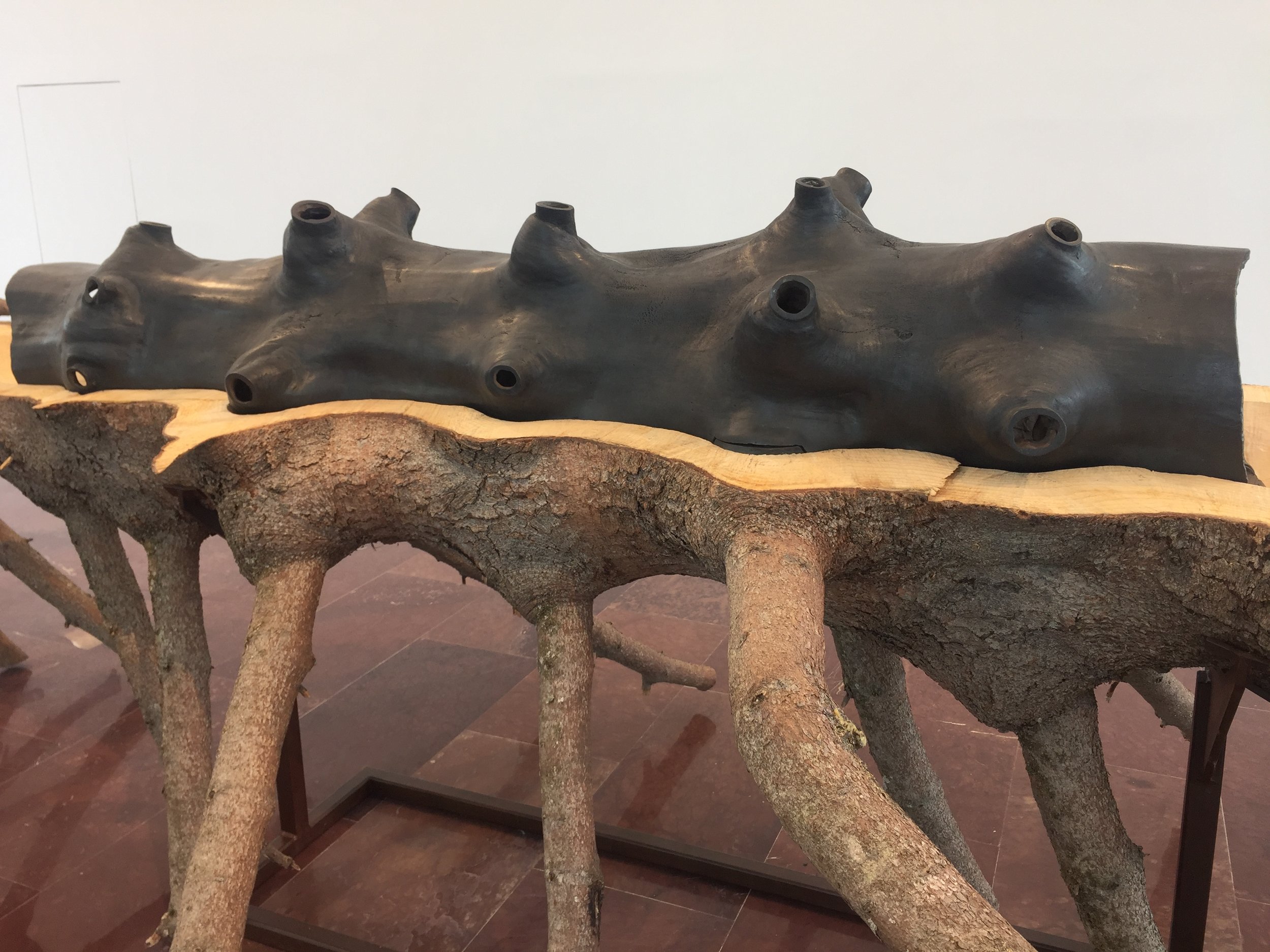THEORY STUDY: GUISEPPE PENONE'S ARTE POVERA - MANIPULATED NATURE
Image courtesy of Fendi
I went to Rome for the weekend after visiting some factories in Italy recently. Although extremely beautiful, being alone in Rome was fairly boring except my time at the Fendi HQ on the outskirts of town. Unbeknownst to me, Fendi actually plays a big role in modern Rome, having paid to restore the Trevi Fountain and taking up headquarters in a building Romans call the 'Square Coliseum.' Locals call the building this because of its classical Roman arches in an otherwise modern rectangular building. The building formally known as the Palazzo della Civiltà Italiana was commissioned by Mussolini, and is a bit of a controversial building on its own given its fascist origins. Designed by architects Giovanni Guerrini, Ernesto Bruno La Padula and Mario Romano, the travertine marble building was intended to be the centerpiece of Mussolini's new Roman empire, but was abandoned after WWII. The building was essentially in disrepair until Fendi took on restoring it in 2015.
Being so bored in Rome got my wheels turning, "what else is there in this great city besides tourist attractions that I can do without knowing any locals? And then it hit me that some Arte Povera artists lived and worked in Rome! After asking around for anything Arte Povera, I was instructed to go to the Fendi HQ to both see the amazingly rehabilitated building and to see Guiseppe Penone's exhibition that is on display on the ground floor of the building.
A long cab ride into what appeared to be 'normal Rome,' ie not touristy or super-duper old, and probably where a majority of Romans live, I reached the monumental building. It seemed like it was five stories in the air, just on the ground level. I entered through the marble stairs and was greeted by one of Penone's trees.
Image courtesy of Fendi
Having recently moved to New York, I actually thought the tree was just a sad winter tree like so many I see in my city, but upon closer inspection, I realized that there were metal pipes and sculptural elements in the 'tree.' Admittedly, my heart raced a little faster once I realized I was looking at Penone's work. There's something so exciting about experiencing something in real life that was once only experienced through the internet.
In the main foyer of the building, I entered the exhibition area where I was immediately confronted by Penone's Soffio di Foglie, or 'Breath of Leaves.' The current exhibition at Fendi is just a recreation of Penone's original, but I presumed that the impression of the human body in the pile of myrtle leaves was created by Penone. My mind went to the images I had seen of his body on the leaves in 1979. I missed that moment in time, but the pile here in 2017 excited me. (Funny how a pile of leaves can do that).
Arte Povera, the genre to which Penone's work belongs, literally means poor art. It is exclusively Italian, and a reaction to the high production and high price ticket art of the post-modern era. Using common objects (such as leaves and trees in Penone's case), Italian artists worked to both criticize contemporary art and to create a new genre.
You can see a brief essay I wrote on Arte Povera here.
Observing Penone's work in such an environment was paradoxical to me, and after I looked at the pile of leaves for a while, I burst out in laughter (thank goodness I was the one of two others visiting at the time). Being in a Mousollini commissioned building that is now operated by luxury brand Fendi is the antithesis of 'povera.' The whole thing seemed ridiculous to me for a moment, but I suppose since arte povera's conception, a gallery setting in and of itself undermines the driving force behind the artwork. And I think that's ok because no matter what the reason it's being made, art really should be for the people, and the first step to getting it there is for it to exhibit in a gallery. Plus artists deserve to have their work exhibited in a respectable place.
Fortunately, the Fendi exhibition was free to enter, so I let my mental tangent stop there. Beyond 'Breath of Leaves' were sculptures of tree forms, holding what looks like pieces of Roman ruins. Penone often examines the tension between humanity and nature, and these pieces fit very well with my experience of Rome where ruins would literally have been engulfed by nature were it not for humans actively manicuring the growth.
Below: Fendi
Blurry image courtesy of my iphone
There was also a black polyptich (top left) comprised of four panels painted black with with graphite haphazardly drawn all over. As I looked at it in amazement, I also recalled a time in my life where I might have thought, "I could have made this." The drawing was seemingly aimless, representing some kind of scales on an animal or maybe the surface of a water worn rock, with solid painted boards that take no real skill. But nowadays I understand that I couldn't have made it, one because I wouldn't have thought of it (most importantly), and two, I didn't make it, Penone did, and if I had used the same materials and had the same objective, my work would have resulted in something completely different.
At the time when Arte Povera was first exhibited, it is said that many critics didn't consider it art. A pile of rocks, sticks and other natural objects especially repulsed lovers of so-called high art, where there tended to be a preference for modern materials such as lucite, acrylic and plaster in sculptures, which is exactly why I look to Arte Povera so often.
Fashion is so overtly made by people of privilege, and it reinforces class structures just by virtue of its cost, and though Bagtazo may not use as common of materials as Arte Povera artists did/do, I like to think of my entire brand mission to be a big 'fuck you' to the mainstream fashion world, so thanks for reading along as I explore my heroes.
Beyond the first section of the exhibition, I found a sparse forest of pillars and a felled Penone tree. I really enjoyed this section, as it seemed to be created for the space. The wood-like glossy stone floors and the stark white gallery walls coordinated with the real wood with rich color variation, made to sit on pillars or plaster looking bases made me feel like I was in a reverse-city setting. Usually human manipulated natural materials creates at least a village-like if not urban environment, but in this case, the natural objects were manipulated to create a man-made natural environment.
Another blurry shot from my iphone
In the second room, one of my favorite pieces lines the wall: Penone's series of self portraits where he made the same expression but changed out reflective contact lenses in some of them. Between my love for repetition, self portraits (not to be confused with selfies), and the subtly of the contact lenses, the photos kept my attention for close to a half hour... I basically just slowly walked past each one, stepped back, look at the series as a whole, went back to inspect each individual photo, etc.
Also, I mean, look how hot he looks:
Penone's self portrait (one of many in a series)
Also in the center of the second room is a hollowed out tree with many broken branches. It reminded me of a canoe or for some reason, a parody of the table used in the Last Supper.
Maybe because Penone grew up in the wooded town of Gargessio, Italy, Penone's work focuses on the connection between humanity and nature. Through this lens, he manipulates nature (much like we do as humans in general), but he keeps much of the natural integrity of his medium, which often deceives the viewer. Like when I mistakenly thought the tree outside was a sad winter tree, for example.
I'm not totally sure what he 'means' by creating any of these things, as I haven't read any interviews or know if he has ever explained his work in terms of meaning to anyone, but I do enjoy considering how keeping the integrity of the natural materials he works with makes me think and feel.
So anyway, if you're in Rome soon, I highly recommend visiting Fendi HQ.
Courtney Bagtazo, © BAGTAZO 2017
BIBLIOGRAPHY
All images not credited, or clearly the artist's original work, were taken on my phone.
How to Spend it, Fendi Salutes Giuseppe Penone in a New Exhibition.
READ THE ENTIRE BLOG

















